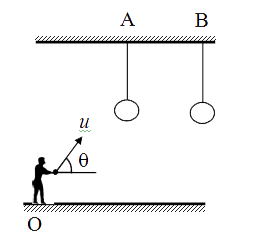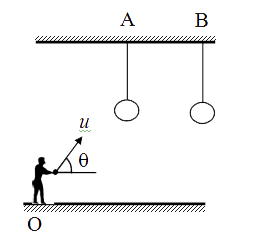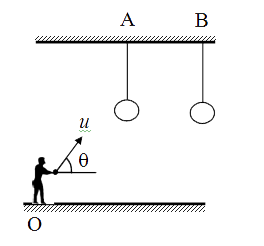A ball does not pass through a copper ring at room temperature. The same ball, after heating, passes through the same ring. It shows due to heating, the ball
expands
contracts
does not change
1 or 2
The correct Answer is:B
To solve the problem, let's analyze the situation step by step:
Step 1: Understand the Initial Condition
At room temperature, the ball is too large to pass through the copper ring. This indicates that the diameter of the ball is greater than the diameter of the hole in the ring.
Hint: Consider the relationship between the size of the ball and the size of the hole in the ring.
Step 2: Heating the Ball
When the ball is heated, it undergoes a change in temperature. According to the principles of thermal expansion, most materials expand when heated. However, in this case, we need to consider the behavior of the ball and the ring separately.
Hint: Recall the concept of thermal expansion and how materials typically react to heat.
Step 3: Analyze the Outcome After Heating
After heating, the ball is able to pass through the ring. This suggests that the ball's effective size must have changed. Since the ball is now able to fit through the ring, we can conclude that the ball must have contracted in size.
Hint: Think about the physical changes that occur in the ball when it is heated and how that affects its size relative to the ring.
Step 4: Conclusion
The correct conclusion is that due to heating, the ball contracts in size, allowing it to pass through the copper ring.
Final Answer: The ball contracts.
Summary of Steps:
1. Identify the initial condition where the ball cannot pass through the ring.
2. Consider the effects of heating on the ball.
3. Conclude that the ball must have contracted to fit through the ring.
At room temperature, the ball is too large to pass through the copper ring. This indicates that the diameter of the ball is greater than the diameter of the hole in the ring.
When the ball is heated, it undergoes a change in temperature. According to the principles of thermal expansion, most materials expand when heated. However, in this case, we need to consider the behavior of the ball and the ring separately.
After heating, the ball is able to pass through the ring. This suggests that the ball's effective size must have changed. Since the ball is now able to fit through the ring, we can conclude that the ball must have contracted in size.
The correct conclusion is that due to heating, the ball contracts in size, allowing it to pass through the copper ring.
1. Identify the initial condition where the ball cannot pass through the ring.
2. Consider the effects of heating on the ball.
3. Conclude that the ball must have contracted to fit through the ring.
Similar Questions
Two rings are suspended from the points A and B on the ceiling of a room with the help of strings of length 1.2 m each as shown. The points A and B are separated from each other by a distance AB = 1.2 m. A boy standing on the floor throws a small ball so that it passes through the two rings whose diameter is slightly greater than the ball. At the moment when the boy throws the ball, his hand is at a height of 1.0 m above the floor. A stop watch which is switched on at the moment of throwing the ball reads 0.2 s when the ball passes through the first ring and 0.6 s when it passes through the second ring.

The angle of projection of the ball is:View SolutionTwo rings are suspended from the points A and B on the ceiling of a room with the help of strings of length 1.2 m each as shown. The points A and B are separated from each other by a distance AB = 1.2 m. A boy standing on the floor throws a small ball so that it passes through the two rings whose diameter is slightly greater than the ball. At the moment when the boy throws the ball, his hand is at a height of 1.0 m above the floor. A stop watch which is switched on at the moment of throwing the ball reads 0.2 s when the ball passes through the first ring and 0.6 s when it passes through the second ring.

The maximum height attained by the ball above the floor is:View SolutionA body is projected upwards with a velocity u. It passes through a certain point above the ground after t1, Find the time after which the body passes through the same point during the journey.
View SolutionTwo rings are suspended from the points A and B on the ceiling of a room with the help of strings of length 1.2 m each as shown. The points A and B are separated from each other by a distance AB = 1.2 m. A boy standing on the floor throws a small ball so that it passes through the two rings whose diameter is slightly greater than the ball. At the moment when the boy throws the ball, his hand is at a height of 1.0 m above the floor. A stop watch which is switched on at the moment of throwing the ball reads 0.2 s when the ball passes through the first ring and 0.6 s when it passes through the second ring.

The projection speed of the ball is:View SolutionTwo rings are suspended from the points A and B on the ceiling of a room with the help of strings of length 1.2 m each as shown. The points A and B are separated from each other by a distance AB = 1.2 m. A boy standing on the floor throws a small ball so that it passes through the two rings whose diameter is slightly greater than the ball. At the moment when the boy throws the ball, his hand is at a height of 1.0 m above the floor. A stop watch which is switched on at the moment of throwing the ball reads 0.2 s when the ball passes through the first ring and 0.6 s when it passes through the second ring.

The projection speed of the ball is:View SolutionA ball 4 s after the instant it was thrown from the ground passes through a point P, and strikes the ground after 5 s from the instant it passes through the point P. Assuming acceleration due to gravity to be 9.8m/s2 find height of the point P above the ground.
View SolutionTwo rings are suspended from the points A and B on the ceiling of a room with the help of strings of length 1.2 m each as shown. The points A and B are separated from each other by a distance AB = 1.2 m. A boy standing on the floor throws a small ball so that it passes through the two rings whose diameter is slightly greater than the ball. At the moment when the boy throws the ball, his hand is at a height of 1.0 m above the floor. A stop watch which is switched on at the moment of throwing the ball reads 0.2 s when the ball passes through the first ring and 0.6 s when it passes through the second ring.

When the ball lands on the floor, the stop watch reads:View SolutionAn iron ball has a diameter of 6cm and is 0.010mm too large to pass through a hole in a brass plate when the ball and plate are at a temperature of 30∘C. At what temperature, the same for ball and plate, will the ball just pass through the hole?
Take the values of (prop) from Table 20.2.View SolutionTwo rings are suspended from the points A and B on the ceiling of a room with the help of strings of length 1.2 m each as shown. The points A and B are separated from each other by a distance AB = 1.2 m. A boy standing on the floor throws a small ball so that it passes through the two rings whose diameter is slightly greater than the ball. At the moment when the boy throws the ball, his hand is at a height of 1.0 m above the floor. A stop watch which is switched on at the moment of throwing the ball reads 0.2 s when the ball passes through the first ring and 0.6 s when it passes through the second ring.

The ball lands on the floor at a distance:View SolutionA ball is released in a smooth dimetrical tunnel of earth
a. After how much time will it pass through the center of earth?
b. With what speeed will the ball pass the center earth?View Solution

